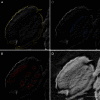Using μPIXE for quantitative mapping of metal concentration in Arabidopsis thaliana seeds
- PMID: 23761799
- PMCID: PMC3669754
- DOI: 10.3389/fpls.2013.00168
Using μPIXE for quantitative mapping of metal concentration in Arabidopsis thaliana seeds
Abstract
Seeds are a crucial stage in plant life. They contain the nutrients necessary to initiate the development of a new organism. Seeds also represent an important source of nutrient for human beings. Iron (Fe) and zinc (Zn) deficiencies affect over a billion people worldwide. It is therefore important to understand how these essential metals are stored in seeds. In this work, Particle-Induced X-ray Emission with the use of a focused ion beam (μPIXE) has been used to map and quantify essential metals in Arabidopsis seeds. In agreement with Synchrotron radiation X-ray fluorescence (SXRF) imaging and Perls/DAB staining, μPIXE maps confirmed the specific pattern of Fe and Mn localization in the endodermal and subepidermal cell layers in dry seeds, respectively. Moreover, μPIXE allows absolute quantification revealing that the Fe concentration in the endodermal cell layer reaches ~800 μg·g(-1) dry weight. Nevertheless, this cell layer accounts only for about half of Fe stores in dry seeds. Comparison between Arabidopsis wild type (WT) and mutant seeds impaired in Fe vacuolar storage (vit1-1) or release (nramp3nramp4) confirmed the strongly altered Fe localization pattern in vit1-1, whereas no alteration could be detected in nramp3nramp4 dry seeds. Imaging of imbibed seeds indicates a dynamic localization of metals as Fe and Zn concentrations increase in the subepidermal cell layer of cotyledons after imbibition. The complementarities between μPIXE and other approaches as well as the importance of being able to quantify the patterns for the interpretation of mutant phenotypes are discussed.
Keywords: Arabidopsis; elemental mapping; iron; quantitative; seed; μPIXE.
Figures






Similar articles
-
Metal Tolerance Protein 8 Mediates Manganese Homeostasis and Iron Reallocation during Seed Development and Germination.Plant Physiol. 2017 Jul;174(3):1633-1647. doi: 10.1104/pp.16.01646. Epub 2017 May 1. Plant Physiol. 2017. PMID: 28461400 Free PMC article.
-
Identification of the endodermal vacuole as the iron storage compartment in the Arabidopsis embryo.Plant Physiol. 2009 Nov;151(3):1329-38. doi: 10.1104/pp.109.144444. Epub 2009 Sep 2. Plant Physiol. 2009. PMID: 19726572 Free PMC article.
-
The Arabidopsis MTP8 transporter determines the localization of manganese and iron in seeds.Sci Rep. 2017 Sep 8;7(1):11024. doi: 10.1038/s41598-017-11250-9. Sci Rep. 2017. PMID: 28887568 Free PMC article.
-
Overexpression of METAL TOLERANCE PROTEIN8 reveals new aspects of metal transport in Arabidopsis thaliana seeds.Plant Biol (Stuttg). 2022 Jan;24(1):23-29. doi: 10.1111/plb.13342. Epub 2021 Sep 21. Plant Biol (Stuttg). 2022. PMID: 34546650
-
Handing off iron to the next generation: how does it get into seeds and what for?Biochem J. 2020 Jan 17;477(1):259-274. doi: 10.1042/BCJ20190188. Biochem J. 2020. PMID: 31950999 Review.
Cited by
-
Metal Tolerance Protein 8 Mediates Manganese Homeostasis and Iron Reallocation during Seed Development and Germination.Plant Physiol. 2017 Jul;174(3):1633-1647. doi: 10.1104/pp.16.01646. Epub 2017 May 1. Plant Physiol. 2017. PMID: 28461400 Free PMC article.
-
Bypassing Iron Storage in Endodermal Vacuoles Rescues the Iron Mobilization Defect in the natural resistance associated-macrophage protein3natural resistance associated-macrophage protein4 Double Mutant.Plant Physiol. 2015 Sep;169(1):748-59. doi: 10.1104/pp.15.00380. Epub 2015 Jul 31. Plant Physiol. 2015. PMID: 26232490 Free PMC article.
-
Laboratory Microprobe X-Ray Fluorescence in Plant Science: Emerging Applications and Case Studies.Front Plant Sci. 2018 Nov 14;9:1588. doi: 10.3389/fpls.2018.01588. eCollection 2018. Front Plant Sci. 2018. PMID: 30487802 Free PMC article.
-
The stage of seed development influences iron bioavailability in pea (Pisum sativum L.).Sci Rep. 2018 May 2;8(1):6865. doi: 10.1038/s41598-018-25130-3. Sci Rep. 2018. PMID: 29720667 Free PMC article.
-
Analytical Methods for Imaging Metals in Biology: From Transition Metal Metabolism to Transition Metal Signaling.Anal Chem. 2017 Jan 3;89(1):22-41. doi: 10.1021/acs.analchem.6b04631. Epub 2016 Dec 15. Anal Chem. 2017. PMID: 27976855 Free PMC article. Review. No abstract available.
References
-
- Briat J. F., Lobreaux S. (1997). Iron transport and storage in plants. Trends Plant Sci. 2, 187–193 10.1016/S1360-1385(97)85225-9 - DOI
-
- Budka D., Mesjasz-Przybylowicz J., Tylko G., Przybylowicz W. J. (2005). Freeze-substitution methods for Ni localization and quantitative analysis in Berkheya coddii leaves by means of PIXE. Nucl. Instrum. Methods Phys. Res. B 231, 338–344 10.1016/j.nimb.2005.01.080 - DOI
-
- Campbell J. L., Hopman T. L., Maxwell J. A., Nejedly Z. (2000). Guelph PIXE software package III: alternative proton database Nucl. Instrum. Methods Phys. Res. B 170, 193–204 10.1016/S0168-583X(00)00156-7 - DOI
LinkOut - more resources
Full Text Sources
Other Literature Sources

